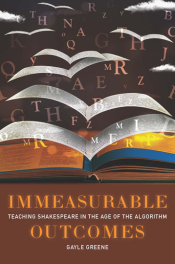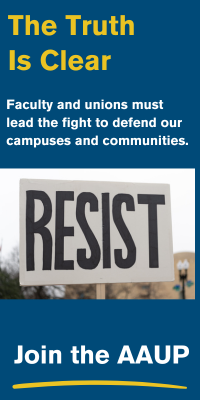- About
- Programs
- Issues
- Academic Freedom
- Political Attacks on Higher Education
- Resources on Collective Bargaining
- Shared Governance
- Campus Protests
- Faculty Compensation
- Racial Justice
- Diversity in Higher Ed
- Financial Crisis
- Privatization and OPMs
- Contingent Faculty Positions
- Tenure
- Workplace Issues
- Gender and Sexuality in Higher Ed
- Targeted Harassment
- Intellectual Property & Copyright
- Civility
- The Family and Medical Leave Act
- Pregnancy in the Academy
- Publications
- Data
- News
- Membership
- Chapters
The Liberal Arts and the Skills-Gap Myth

Immeasurable Outcomes: Teaching Shakespeare in the Age of the Algorithm, by Gayle Greene. Johns Hopkins University Press, 2023.
The current attack on liberal arts majors has deep roots in the modern education reform movement, which can be traced to the presidential administration of Ronald Reagan. In 1983, the Reagan administration published the infamous report A Nation at Risk, which marked the beginning of a campaign to create the myth of a skills gap among US students. Subsequently, Reagan’s politicized federal agencies funded research at the Hudson Institute and numerous universities and schools of education, including Columbia University’s Teachers College, to attribute the skills gap to purportedly failing schools in a labor market requiring high educational and skill levels. The skills gap became the main rationale for K–12 reform policies, including those promoting charter schools, private-school vouchers, and test-based accountability.
Decades later, corporations and foundations would extend this logic to higher education, claiming that colleges and universities are failing to produce adequately skilled graduates. In this narrative, technical skills—mainly those required in STEM fields—should be the focus of higher education. Reformers therefore seek to limit liberal arts fields to general education offerings, except at flagship universities and elite private colleges, where they will remain as majors available to higher-income students.
Despite its lack of connection to empirical reality, the skills-gap campaign has become dogma in mainstream higher education policy discourse and provided a foundation for austerity budgeting—serving as a pretext for the gradual, systematic defunding of public higher education. According to the campaign’s logic, if higher education is not producing sufficiently skilled graduates, then surely it deserves fewer of our tax dollars. As a result, today many states, even those with large budget surpluses, are cutting funding for their higher education systems, and one of the first areas where education reformers propose cuts is to degree programs in the liberal arts. In the mythical labor market of higher education reformers, working-class and lower-income students—who disproportionately attend regional comprehensive universities and community colleges—should have access only to technical fields.
Enter Gayle Greene’s outstanding book, Immeasurable Outcomes: Teaching Shakespeare in the Age of the Algorithm. Greene—professor emerita at Scripps College, a Shakespeare scholar, and a true public intellectual—has authored numerous books on a diverse range of topics in addition to many articles in popular media outlets. Immeasurable Outcomes represents the wisdom accumulated through her decades of experience teaching Shakespeare to undergraduates. While Greene’s book brilliantly captures the complex dynamics of classroom teaching, her analysis of the corporate- and foundation-driven education reform movement is especially insightful, placing the assault on the liberal arts in its proper context.
Immeasurable Outcomes is truly original, one of the most effective defenses I have ever read of both the liberal arts and face-to-face education. According to conventional wisdom—which faculty are left to rebut as colleges and universities bow to corporate pressures—liberal arts majors are simply no longer “relevant.” In the language of business, the return-on-investment of an English or history major no longer justifies maintaining these degree programs at cash-strapped institutions. As colleges and universities compete to add STEM programs, even in a market with few STEM jobs, public higher education leaders advance austerity policies as if they had no choice at all. Greene’s beautifully written defense of the critical importance and educational value of the liberal arts provides a needed corrective to the destructive mindset of neoliberal public policies that privilege business interests.
In several chapters, Greene chronicles her teaching of Shakespeare’s plays to undergraduates. Descriptions of her seminars vividly capture the dynamics of what educators do with students every day, not only in classrooms but also in labs, art studios, offices, hallways, or quads. We enter into dialogue with our students. We “read” students and try to draw out the more reticent ones while making sure that a small number don’t dominate class discussions. We try to work with what every student says, always striving to move the whole class forward as a group.
Greene’s stories reveal what all teachers at any level of education know: We can’t always predict where any given class will go because each group is different. But as experienced teachers, we learn to navigate the journey. Beyond knowledge of specific content areas, teaching requires human skills that technology can never replicate or replace. Greene’s book is among the best accounts of what teachers do with and for students every day. It’s a subject that you don’t often encounter in a higher education press increasingly enamored with selling corporate products and services and focused more on reminding the academic community that the public has lost confidence in what we do than on discussing what higher education is actually about: teaching and learning.
While the chapters on classroom teaching and learning are a pure joy to read and will resonate with every faculty member, Greene’s chapter on assessment, appropriately titled “De-grading the Professors: Outcomes Assessment Assessed,” is worth the price of admission. Assessment is one of the least understood practices in higher education. It is a product of the skills-gap campaign: Higher education takes the interest-group claims of business leaders at face value, as if they were not self-interested. When surveys of CEOs (or anecdotes) suggest that businesses simply cannot find enough skilled workers, higher education dutifully responds by documenting anything at all that our students have learned. Because such external critics report that our graduates are never skilled enough—regardless of the decade (or century)—we must continually assess what our students are learning to prove our worth. Apparently, record-high stock markets and corporate profits have been achieved with a poorly qualified workforce.
Greene astutely dissects the language and ostensible purposes of assessment. Because of the critical lens she brings to the subject matter, she dares to question what higher education leadership simply accepts: “Hyphenated words have a special pizzazz—value added, capacity building, performance-based, high-performance—especially when one of the words is data: data driven, data-based, benchmarked-data,” she writes. She demolishes the basic assumptions of assessment, which relies exclusively on learning outcomes that can be easily measured, as opposed to outcomes that are less easily measured. Greene shrewdly responds, “Wait a minute, I thought getting students to understand, feel, learn, appreciate, grasp the significance of, enjoy—was sort of the point.” She also correctly identifies the culture of compliance that the assessment juggernaut has built, a culture in which the professional judgment of faculty is never to be trusted since the mistrust of all educators is another core belief of the education reform movement.
In addition, Greene accurately labels the Gates Foundation’s Postsecondary Value Commission (PVC) a “lobbying group,” and her analysis of the organization is spot-on. Like nearly all other foundation and corporate education reformers, the PVC incessantly discusses its concern with “equity” and “access.” Greene correctly notes that PVC’s Equitable Value “report is draped in the rhetoric of social justice.” She insightfully points out that the PVC is part of the larger corporate education-reform movement that ultimately “blame[s] the educators” as the commission’s report argues that higher education should “dismantle its own inequitable policies and practices.” The larger political economy, of course, is nowhere to be found in this account, which holds higher education responsible—as A Nation at Risk held responsible the K–12 school system—for all sorts of social inequalities well beyond its control.
Immeasurable Outcomes should be mandatory reading for all college faculty members, administrators, and education journalists before the corporate- and foundation-led higher education reform movement makes liberal arts majors—not to mention in-person instruction—available only to the children of the nation’s elite. Along with books such as Jon Shelton’s The Education Myth and Annie Abrams’s Shortchanged, Greene’s book breaks new ground in a mainstream debate increasingly dominated by the corporate framing of education built on the erroneous assumptions of neoliberalism and human capital theory. We must follow the lead of these authors. The future of education, and of the fragile state of our democracy, depends on it.
Neil Kraus is professor of political science at the University of Wisconsin–River Falls. He is the author of three books, including The Fantasy Economy: Neoliberalism, Inequality, and the Education Reform Movement (Temple University Press, 2023), as well as several articles on education policy, inequality, and urban politics and policies. His email address is [email protected].



